Creating an SCD transform - type 2 (historical attributes)
To me, this is the most useful type of SCD: one where you capture the history
of changes made to the grade. Here's how it works.
Changes needed to our dimension table
The first part of this blog got you to set up the data we needed. You
now need to add 3 additional columns to the dimension table to allow us to
capture historical data. To do this, run this script:
BEGIN TRY
DROP TABLE DimPerson
END TRY
BEGIN CATCH
END CATCH
CREATE TABLE dbo.DimPerson(
SurrogateKeyId int IDENTITY(1,1) NOT NULL,
PersonId int NOT NULL,
FirstName nvarchar(255) NULL,
Surname nvarchar(255) NULL,
Grade varchar(50) NULL,
GradeStatus varchar(50) NULL,
FromDate date NULL,
ToDate date NULL
)
SET IDENTITY_INSERT dbo.DimPerson ON
INSERT dbo.DimPerson (
SurrogateKeyId,
PersonId,
FirstName,
Surname,
Grade,
GradeStatus,
FromDate,
ToDate
) VALUES (
1, 1, N'Rita', N'Smith', N'Office junior',
'Current','01/01/2000',Null)
INSERT dbo.DimPerson (
SurrogateKeyId,
PersonId,
FirstName,
Surname,
Grade,
GradeStatus,
FromDate,
ToDate
) VALUES (
2, 2, N'Bob', N'Brown', N'Office junior',
'Current','01/01/2000',Null
)
INSERT dbo.DimPerson (
SurrogateKeyId,
PersonId,
FirstName,
Surname,
Grade,
GradeStatus,
FromDate,
ToDate
) VALUES (
3, 3, N'Sue', N'Jones', N'Office junior',
'Current','01/01/2000',Null
)
SET IDENTITY_INSERT dbo.DimPerson OFF
SELECT * FROM DimPerson
Running this should give a squeaky clean new table:

We can track changes either using the selected
GradeStatus column, or the FromDate and
ToDate columns.
It's vital that existing dimension table records contain sensible values for
the historical status columns, otherwise SSIS has nothing to pick up on when
adding new rows.
Creating the SCD type 2 transform
Those who have read this far will know what comes next!
- Create a new package.
- Create a new data flow task within it.
- Add an OLEDB source to take data from the
vwPromotions view.
- Add a Slowly Changing Dimension transform.
What you should now be looking at is something like this:
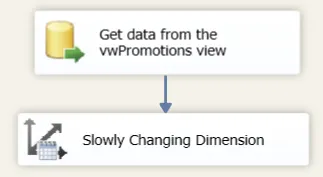
The start of the package - time to configure our SCD transform!
Double-click on the SCD transform and configure it as described below.
After missing out the first stage (if it even appears), you can specify which
columns contain changes to the dimension table that you want to track:
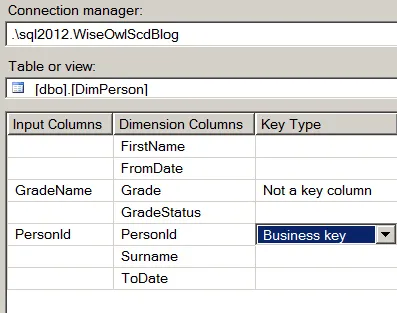
We'll track changes to the
Grade column only, and use the
PersonId to match rows between the transactional database source table and dimension table target.
If you're not sure what to do above, I've described it in more details in the
previous parts of this blog.
In the next stage of the wizard, say that you want to keep a historical
record of changes:
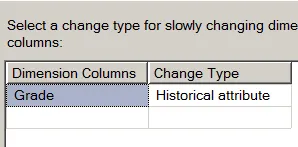
We want to track changes to the
Grade column, and keep a history of previous ones.
You can now configure how you want to track historical data, either by using a
single column or start and end dates (described under separate headings below).
Using a single column to track changes
If you just want to track whether a row is current or has expired, choose
these options:
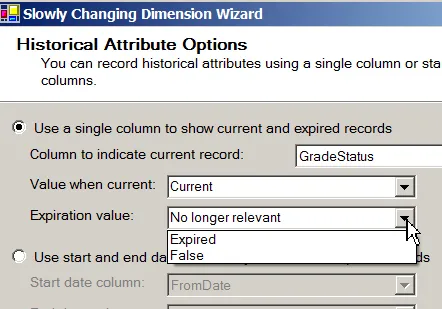
We'll use the
GradeStatus column to track whether a row is current or not.
Note that although the Expiration value dropdown only gives
two values, you can type in your own (here we've typed in No longer
relevant). You can now go through the rest of the wizard,
choosing not to use inferred members (these are described in the next part of
this blog), to give:
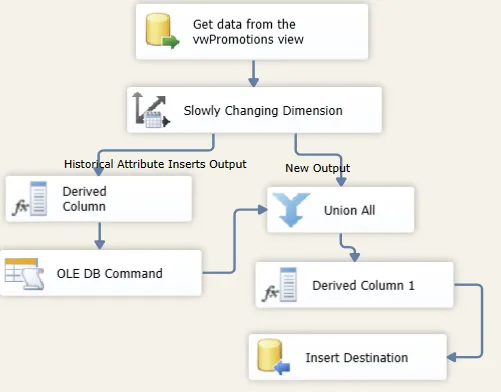
The resulting package.
When you run this, this is what the DimPerson dimension table
should look like:
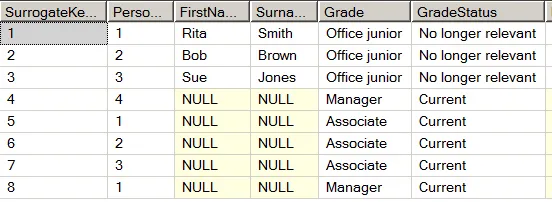
The
GradeStatus has been updated for old records, but hasn't been correctly set for interim new ones.
The problem shown above - that interim rows show up as Current
- shouldn't be a problem in a real-world example, since they're called "Slowly
Changing Dimensions" for a reason, and if you run regular updates you'll never
by making two changes in the same package.
Using a start and end date to track changes
This option seems better, simply because it captures more data (often it's
not enough to know whether a row is obsolete or not - you need to know when the
change occurred). Here's how to track changes using a start/end date.
First (optionally) create a variable:

We'll assume updates are occurring on 1st January 2015.
Now configure the historical attribute as follows:
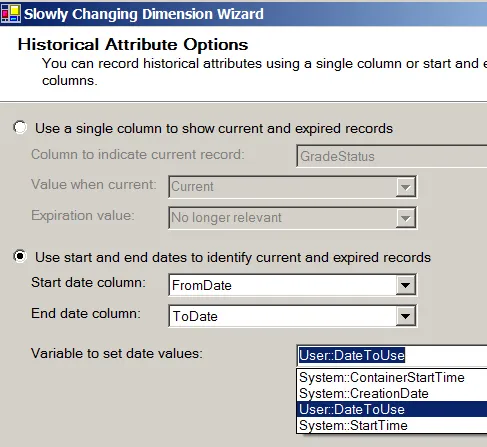
By this point it's normally fairly obvious what to do. Rather than assuming changes occurred today, we'll use 1st January 2015 instead.
Step through the rest of the wizard (choosing not to implement inferred member
support, which is covered in the next part of this blog) to get:
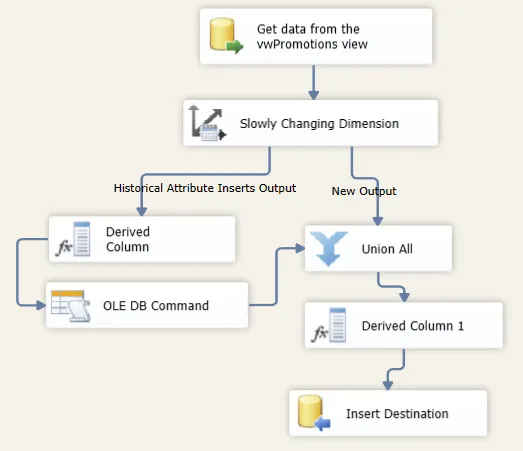
The final package looks the same as for a single column.
Run this package to get:
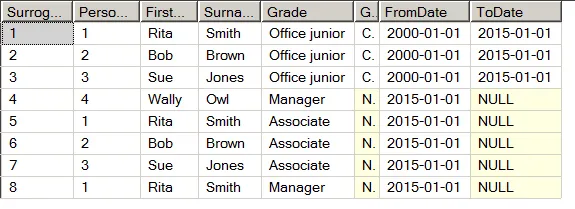
The start dates and end dates have been set correctly.
Note that as for the single-column example above we have a problem if more than
one update is made to the same row (Rita Smith's promotion to Associate
incorrectly doesn't have an end date). In a real-life scenario this is
unlikely to be a problem, as updates will be scheduled overnight and changes
will happen only occasionally.
If you're going to use SCDs (and the final part of this blog considers
reasons why you might not) a type 2 SCD tracking historical changes with start
and end dates seems the best way to do it.
Before we look at some disadvantages of Slowly Changing Dimension transforms,
let's take a brief digression to look at inferred members.















